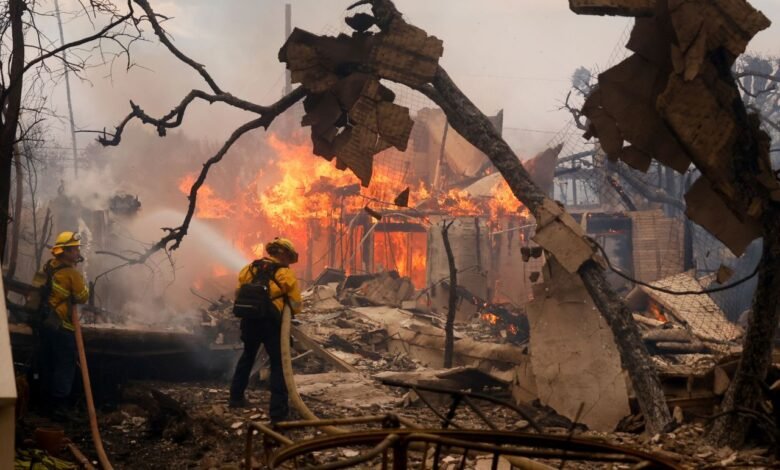
Breaking: Deadly LA Wildfires Kill 2, Destroy 1,000 Homes
Deadly wildfires have torn through Los Angeles, killing two people and destroying about 1,000 homes. This marks one of California’s most destructive fire events in recent years. Strong Santa Ana winds have pushed these blazes forward, and thousands more structures remain at risk.
Several fires broke out at once in the Pacific Palisades area. Firefighting crews are working against extreme conditions to save residential neighborhoods. Emergency teams ordered mandatory evacuations that forced more than 10,000 residents from their homes, while the fires continue to burn uncontrolled.
The fires have cut a path of destruction through many communities. Firefighters face unprecedented challenges because of severe drought and wind speeds that reach 60 mph. Local officials say the situation remains dangerous, and weather forecasts show hazardous fire conditions will likely continue for days.
Rapid Fire Spread Timeline
Los Angeles County faced multiple devastating fires that started with the Palisades Fire at 10:30 AM Tuesday near Piedra Morada Drive. The flames spread faster than expected and burned through nearly 3,000 acres, which forced about 30,000 people to leave their homes.
First Blaze in Pacific Palisades
The fire that started in Pacific Palisades grew out of control and jumped across the Pacific Coast Highway before reaching the coastline. Powerful wind gusts up to 80 mph pushed the flames through the wealthy coastal neighborhood. The fire became so intense that it created massive traffic jams, and many people had to leave their cars behind and run to safety.
Secondary Fires Emerge
The situation got worse when the Eaton Fire started at 6:30 PM in the Altadena area, north of Pasadena. This new fire grew to 10,600 acres in just a few hours with firefighters unable to contain it. A third major fire, called the Hurst Fire, broke out at 10:30 PM in the Sylmar area and spread to 500 acres.
Overnight Destruction Path
Emergency teams faced unprecedented challenges as the fires spread through the night. The destruction included:
- Wind gusts that reached 99 mph near Altadena
- More than 100 schools had to close
- About 1,000 buildings were destroyed
The National Weather Service said the worst conditions would happen between 10 PM Tuesday and 5 AM Wednesday. Officials called it a “life-threatening and destructive” windstorm event because of the hurricane-force winds and very dry conditions.
Critical Damage Assessment
The Los Angeles County Fire Department reports massive destruction in several communities. The damage is extensive in Pacific Palisades and Altadena areas. Two people died in the Eaton fire zone, while many residents who stayed behind suffered serious injuries.
Structural Losses and Casualties
The fires have burned down about 1,000 structures in the Pacific Palisades area. The Eaton fire destroyed 100 more structures. These devastating fires forced more than 70,000 LA County residents to evacuate their homes.
Infrastructure Impact
Essential services have broken down due to the widespread destruction. Power outages affected over 400,000 homes and businesses. The city’s water system faced major problems:
- Water pressure fell as usage jumped to four times normal levels
- Three tanks holding a million gallons each ran empty
- Many fire hydrants stopped working during critical firefighting operations
Economic Cost Estimates
AccuWeather estimates total damage and economic losses between AED 190.94 billion and AED 209.30 billion. J.P. Morgan analysts expect insured losses could reach AED 36.72 billion. These numbers are staggering because:
- Pacific Palisades homes cost more than AED 11.02 million on average
- The fires threaten 13,000 more homes
- Insurance companies struggle to handle claims, and many have stopped covering high-risk areas
The Los Angeles Department of Water and Power and Southern California Edison found no equipment problems linked to how the fires started.
Weather Conditions Fueling Crisis
Los Angeles faces a perfect storm as extreme weather conditions fuel the ongoing wildfires. The National Weather Service has recorded the strongest winds in the region since 2011.
Santa Ana Wind Impact
The Santa Ana winds brought hurricane-force gusts that swept through Los Angeles County. Wind speeds reached staggering levels:
- 99 mph near Altadena
- 98 mph near Woodland Hills
- 84 mph at Hollywood Burbank Airport
These powerful gusts created a high-speed air current over Los Angeles County that made firefighting difficult and helped fires spread faster.
Drought Conditions
Downtown Los Angeles has received just 0.16 inches of rain since October 1st – far below the normal 4.64 inches for this period. The unusual combination of a wet winter and scorching summer created thick vegetation. This vegetation has now become dangerous fuel for fires.
Weather Forecast Concerns
The National Weather Service warns that dangerous fire conditions will last through Thursday. While wind speeds should drop slowly, experts predict another Santa Ana wind event on Friday. This upcoming event should follow typical patterns, mainly affecting the area from Santa Clarita Valley to Point Mugu.
Climate scientists link these conditions to broader climate change patterns. Rising temperatures have made wildfires more frequent and severe throughout California. Data shows that summer burned areas in northern and central California grew five times larger between 1996 and 2021 compared to the previous 25 years.
Emergency Response Efforts
LA County Fire Chief Anthony Marrone said local firefighting teams can’t handle four major fires at once. “There are not enough firefighters in LA County to address four separate fires of this magnitude,” he explained.
Firefighting Challenges
Fire teams faced big problems when all water storage tanks in the Palisades area “went dry” early Wednesday at 3 AM. The water system had to handle four times its usual load for 15 straight hours, which made fighting fires much harder. Strong winds made things worse by forcing all firefighting aircraft to stay grounded from 7 PM Tuesday.
Evacuation Operations
Emergency teams had to use bulldozers to push away abandoned cars. This cleared paths for both fire trucks and residents trying to escape. The Red Cross quickly set up several emergency shelters. The Westwood Recreation Center took in people fleeing the Palisades Fire, while those escaping the Hurst Fire went to the Ritchie Valens Recreation Center.
Resource Deployment
The Biden administration sent significant federal help, including:
- Five U.S. Forest Service Large Air Tankers
- Ten federal firefighting helicopters
- Two Modular Air Firefighting System units from California National Guard
- Ten Navy helicopters with water delivery buckets
The Governor’s Office of Emergency Services also positioned:
- 65 fire engines
- 120 additional firefighting resources
- 45 CAL FIRE engines
- Six hand crews across seven affected counties
FEMA Administrator Deanne Criswell is heading to California to check the damage and see what communities need. FEMA has approved grants to help California pay for firefighting costs. Officials warn that the situation remains very dangerous and ask residents to leave right away when told.
These Los Angeles wildfires stand as one of California’s most catastrophic fire events that claimed two lives and destroyed over 1,000 homes. Record-breaking Santa Ana winds reaching 99 mph drove multiple blazes and overwhelmed emergency response capabilities. The firefighting teams couldn’t handle their work because depleted water systems and grounded aircraft hampered their efforts.
Weather forecasts show dangerous conditions will continue through Thursday. A new Santa Ana wind event could hit by Friday. The crisis might worsen before it gets better because of severe drought conditions. Local residents should stay alert and follow evacuation orders while emergency teams work non-stop against nature’s fury.
Scientists have linked these devastating fires to broader climate patterns, showing California’s growing vulnerability to extreme weather events. Emergency response teams keep fighting these unprecedented blazes. Thousands of residents can only wait for news about their homes and communities.




